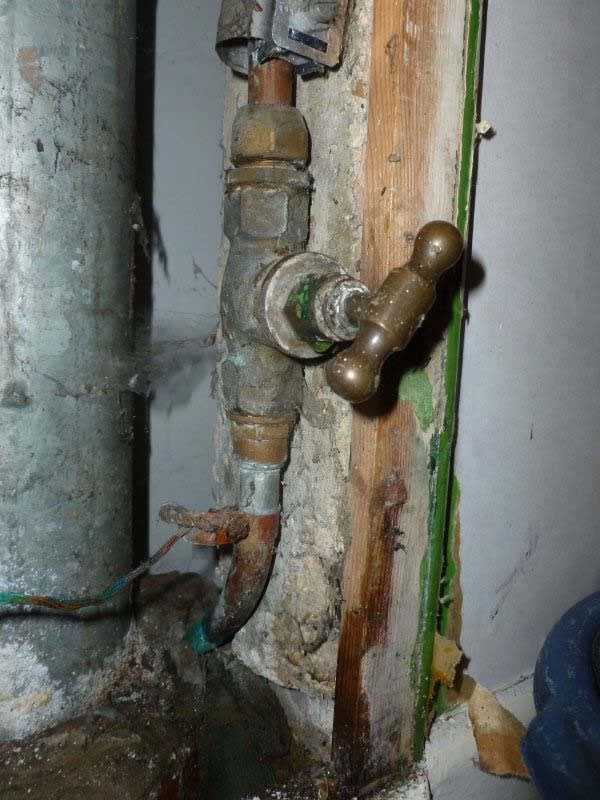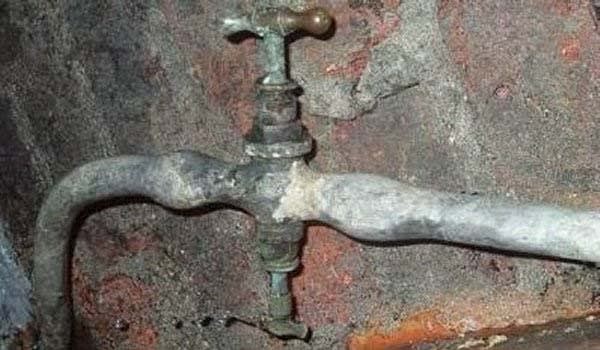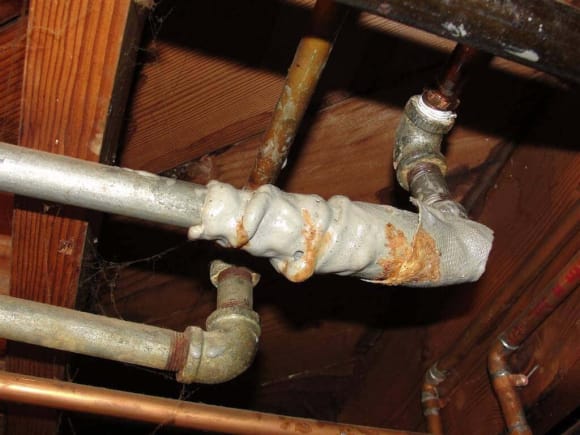Water Stopcock | Boiler Stopcock | Old Pipe Fittings | DesignSpark
Follow articleHow do you feel about this article? Help us to provide better content for you.
Thank you! Your feedback has been received.
There was a problem submitting your feedback, please try again later.
What do you think of this article?
I was repairing a leaking sink tap the other day, in my relatively newish house of ten years of age, anticipating a cheap washer change fix, instead, I had to purchase some cartridge gizmo complete with new shiny covers, ho-hum. I did have to grind the base of those covers down to fit on the tap unit, but that’s another tale. What I began to wonder about whilst tap-tinkering was the very old and very hard to move stopcock that was resident in my old home that was built in 1936. This stopcock scared me like nothing else upon this earth, buried below my sink, mounted atop a frail-looking pipe, which I can only assume was lead and a mere inch proud of the solid concrete floor of my kitchen. Plated in decades of paint, this thing was the bane of my existence should ever a tap need a repair or perhaps even my old Potterton boiler needed a tweak.
A close relative of the dreaded stopcock
The good fight
Braced with an assortment of plumbers weaponry, I would embolden myself with heroic images of knights riding into battle, brave soldiers storming a beachhead and set to the task of…eek…turning it off! This stopcock didn’t like to move, anywhere, creaking and groaning under the excessive loads I was applying, whilst also trying to prevent the ruddy thing from shearing off the naff bit of pipe poking its nose through a couple of feet of the finest, hardest concrete. Thankfully it never did give up the ghost and leave me floundering in a high-pressure shower blast and thus I am eternally gratefully for now living with a stopcock that moves with the merest tweak of the tap. Bliss.
This got me thinking, what if I had had the need to change that god-awful thing, if indeed I had mangled it or if I fancied changing it for a new one, perhaps a digitally controlled device that monitors the flow of water, reacting to a leak in the system somewhere, would it have been an easy task? What are the options for all those ageing systems out there? Some of them must be at least 150 years old perhaps even more and it wouldn’t be easy for the average Joe.
Now, don’t get me wrong, I have brazed many a copper pipe, having previously built Autoclaves a number of moons ago, a vast sea of copper pipes of all manner of sizes decorated these machines, but none of them had that crumbling old stopcock staring at me. I set to task, seeing just what options there are out there for the beleaguered home repairs specialist (who doesn’t like spending money on Plumbers, let’s be honest here).
A word to the wise…
Oh, remember to turn off your mains water supply using the stopcock generally located outside your home (if you can move it!), before hacking into your pipework! Unless you like the idea of an indoor water feature. Oh, and I’m not a Plumber either, so please excuse any misplaced terminology!
Lead pipe complete with a VERY old stopcock, the stuff of nightmares
The dreaded Pipe of Lead
Apparently these old lead pipes are still found in abundance in homes from a certain era, lead was used due to being easy to manipulate and being resistant to pin-hole leaks, but still, rather heavy, one would have thought. Retrofitting these requires the use of a fitting called a Lead-Bloc, certainly a new term for me, this is a compression fitting that converts your previous imperial sized pipe to the more common 15mm/22mm fitting. The only thing is you have to hack a lump of the pipe off and take it to the plumbing specialists to get your correct size of Lead-Bloc, unless you are very nifty at measuring, so make sure you can do this when the shops open! It also helps to have a decent bit of pipe to hack into…out with the jackhammer if you are not so fortunate. Of course, if you can actually remove the old stopcock, great, that makes things a little bit easier. When fitting your Lead-Bloc you may have to shave the lead pipe to fit into the metric fitting with a blade such as a Stanley Knife, again, great fun in a cramped space. At the very least you can add ‘Professional Lead-Pipe Whittler’ to your CV.
Lead-bloc and some shaved lead pipe
Real Steel
If you happen to stumble across a galvanised steel mains water inlet, then it’s either going to work in your favour or not. Will you be able to remove that ageing old stopcock? Will you end up having to cut your way through a thick steel tube with a junior hacksaw in a space that would qualify as a bedroom for a mouse? Is the pipe rusted through? It’s a combination of pot-luck, brute force and a generous splash of ignorance in many cases. If you are lucky enough to remove that old stopcock, chances are you will be able to determine what BSPT is lurking on the old pipe, or take the old stopcock to the merchants for their help. Then it’s a matter of fitting the adaptor (with a nice bit of copper pipe brazed-on in situ, or compression joint fitted) to the steel pipe with a dash of PTFE tape so you can feel free to fit whatever new stopcock device you desire.
Galvanised steel pipe water pipes connected to copper complete with naff repair
Now if you had to hacksaw your way through an inch or so of 80-year-old steel to release that pesky old stopcock and if you have enough steel left poking out of the ground, you will have the absolute joy of trying to rethread that old pipe. Anyone who has cut a thread by hand on a steel bar or tube will be familiar with the process, using a die to cut the thread, back and forth, a bit of lubrication. Not much fun if the pipe is pressed up against the wall and the area you have to work is matchbox sized. Now, ratchet pipe-threading tools are a boon if you have one or can hire one, making life a bit easier, space permitting, it’s not so much fun to do it the old-fashioned way with a selection of dies, spanners, elbow grease and pot-luck. Good luck with that one!
Compression fittings and check valve on copper pipe
The joy of copper
Copper pipes! What can we say about them? It should be plain sailing if you have yourself a nice copper pipe to deal with, perhaps one of the only issues will be gathering the correct size fittings if the pipe is pre-metric. Compression fittings, reducers, brazing, the choice is yours, just make sure you have decent kit, nothing is worse than trying to do things on the cheap only to have those tools let you down. Copper piping is certainly far easier to deal with than any of the above-mentioned perils when it comes to retrofitting.
Plastic domestic water pipe fittings
The Plastic Solution
As with any retrofitting task, once you have established a nice clean and user-friendly option from which you can add additional pipework to the old system, you could opt for plastic pipework. An abundance of fittings are available that will allow you to fit plastic fittings to a copper mains system, or plastic pipes, a browse of any plumbers merchants will reveal all, simple to use and generally a push-fit, twist lock or a compression fit securing them in place. No brazing…no spanners, although I have found that at times you need a fair bit of force to assemble the push-fit ones and require a degree in fiddleology to get apart, where you must push and pull at the same time to separate (which is never as easy as it looks). Swearing helps when dealing with push-fit plastic pipe fittings, warn those who share your home with you first should they think you are involved in some altercation.
Perhaps things have moved on somewhat from my days of dealing with plastic fittings, I often found them prone to leaking if, for example, during assembly, a pipe caught on the fittings internal ‘O’ rings when assembled. Much like the central heating in my home that features plastic and copper pipes and these fittings, great fun when one in the corner of my living room leaked last year and I had to remove a chunk of plywood flooring to get at it, turns out the Plumber hadn’t tightened it up. Pah!

Stopcock or a Gate Valve or a…er…thingy?
When is a stopcock not a stopcock?
When it’s Gate Valve a Ball Valve or maybe even a Globe Valve and so on and so on. There is certainly a very varied selection of valves out there, in all manner of sizes and for all manner of purposes, but be assured the only one you need for your domestic supply is a stopcock, be that digital or you good old manual version.
Stopcocks are designed to deal with the higher pressure associated with mains water so don’t fall foul of fitting a Gate Valve into your domestic system, these are designed for low-pressure use such as you would use to control the drain on a water tank. That being said there are plenty of valve variations that can cater for higher pressures fluids, but these are generally not the ones you would find in the local plumber merchants being designed with industrial applications in mind. As for the other selection of valves you may find, most of you would be hard pressed to even consider fitting them into a domestic situation. Butterfly Valves, and Knife-Gate Valves spring to mind, generally you would never even come across these unless you are in an industry that utilises them.
Alternatives
Electrically controlled stopcocks are becoming increasingly popular, some being based around a solenoid valve to simply open and close the system, while the new kids on the block can monitor pressure, flow rate and can even detect leaks and shut the supply down. Certainly, this trend is leading towards convenience for the user and as an asset for dealing with potential burst pipe scenarios, along with the potential for saving water. All very clever!

So you have retrofitted your old mains water pipe with whatever necessary fittings you needed, the new stopcock is in place and the pipework is complete it’s time to switch on the external stopcock that feeds your property. Fingers crossed that when you do that and then either manually turn on your stopcock, or press some buttons to activate a digital version, all should be well with the world. Hopefully, a leak-free vision will greet your eyes, if not, well it’s out with the spanners, the PTFE tape, and some manly grunting or perhaps your digital multi-meter?
If this article has whet your appetite for some adventures in plumbing and domestic water management you may be interested in taking part in our leak killer challenge?








